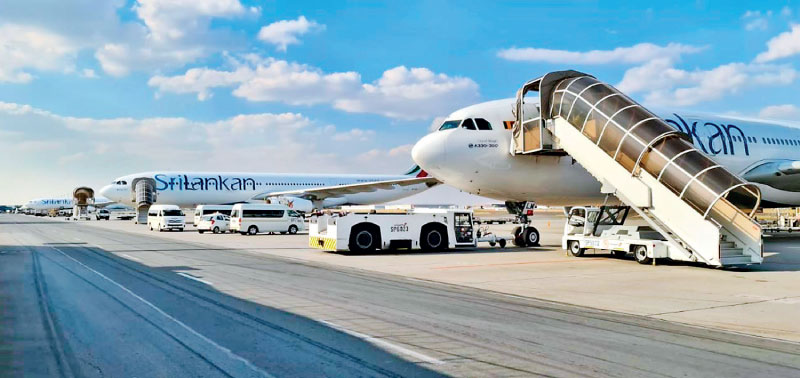Sunday Apr 20, 2025
Sunday Apr 20, 2025
Monday, 1 August 2022 00:15 - - {{hitsCtrl.values.hits}}

 With the country embroiled in a financial meltdown of unprecedented proportions, on Wednesday, 20 July 2022, Parliament confirmed Ranil Wickremesinghe as the nation’s eighth Executive President by a clear margin.
With the country embroiled in a financial meltdown of unprecedented proportions, on Wednesday, 20 July 2022, Parliament confirmed Ranil Wickremesinghe as the nation’s eighth Executive President by a clear margin.
One of the many challenges facing the new President is the future of the State-owned national carrier, SriLankan Airlines. A perennially loss-making State-owned enterprise (SOE), the airline is surpassed only by the Ceylon Electricity Board (CEB) and Ceylon Petroleum Corporation (CPC) as a drain on the nation’s balance sheet.
A short history
The nation dipped its collective toes into the airline business when Air Ceylon (AE) was founded in 1947. Chronically underfunded, AE lurched along for three decades with several foreign airlines as ‘partners’, successively, until, by 1978, it was left with only two aircraft and a handful of routes.
A new long-haul airline was to be established, named Air Lanka (UL), to service the tourist trade and the growing labour market in the Gulf. Poor old Air Ceylon succumbed to the inevitable when one of its two remaining aircraft was destroyed by a bomb in September 1978.
Despite starting off with a flourish, Air Lanka became dogged by controversy soon afterwards. Questionable aircraft purchases fuelled a rapid expansion that was stymied by the damage the country’s tourist trade incurred with the growing Tamil separatism-motivated insurgency, which escalated with the terrible ‘Black July’ race riots of 1983.
In 1998, Emirates Airlines of Dubai bought a stake in UL, signed a 10-year management contract, and embarked on an expansion program. The same year, the Lankan carrier was re-branded as SriLankan Airlines while acquiring six brand-new Airbus A330-200s and an additional A340-300. These plans too hit a speedbump with the attack on the Katunayake airport in July 2001, which destroyed four airliners and damaged another two.
The management team chose not to replace the destroyed aircraft but downsized the airline significantly, enabling UL to stay in business. Crucially, no State funds were called for, with the insurance pay out and the sale of some assets proving sufficient to keep the airline flying for the remainder of the 10-year ‘strategic partnership’.
Back to the arms of the State
Emirates did not renew the ‘partnership’ when it expired in 2008, and the Government of Sri Lanka (GOSL) purchased the 43.6% share owned by the Dubai-based airline in 2010. From then on, UL went back to losing money after a period of relatively prudent fiscal management.
A hugely controversial purchase of multiple Airbus aircraft in 2013 became even more tainted with the manufacturer admitting in court that it had paid many millions in ‘commissions’ to the spouse of a Senior Executive of the airline.
The airline’s accumulated losses since its inception are in the region of Rs. 542 billion, or about $ 1.5 billion. In addition, the company has a debt burden of around $ 850 million plus unpaid aircraft lease costs, which have not been officially disclosed but are estimated to be more than $ 120 million.
According to media reports, the country’s newly appointed President Ranil Wickremesinghe, recently stated that his administration would oversee the airline's privatisation.
Can SriLankan be privatised?
Airlines the world over have had a few torrid years with COVID-19, all but stopping the tourist trade. With the pandemic receding, there has been a rapid recovery, and some companies are approaching a return to profitability.
The airline business is notoriously seasonal, with the summer peak (July/August) and Christmas being some of the more reliably lucrative periods. Remaining profitable at other times of the year, known in the industry as the ‘shoulder period’, is the challenging part of the business.
As recently as March this year, UL’s senior management claimed that the airline had ‘turned the corner’ and announced plans to ‘go it alone’ without GOSL support. However, later reports indicate first-quarter losses for 2022 far in excess of previous years’ figures.
In view of the latest fiscal reports and the continuing lack of fuel in Colombo, the company’s base, it does not appear that there will be many suitors for the airline itself, and a full-year profit looks unlikely.
However, the UL Group, which includes SriLankan Catering, has some potential. Catering and Ground Handling are monopoly licenses held by the national carrier. Ground Handling functions are an integral part of the airline but spinning them off into a separate entity (like SL Catering which has its balance sheet) is not a complicated exercise.
In addition, the airline’s hangar-based Maintenance and Repair Organisation (MRO) and its considerable airport security arms are viable businesses too. The sale of these entities would help repay some portion of UL’s debt, wholly guaranteed by GOSL.
This would leave the core ‘air transport’ on its own. But with a greater portion of the debt removed by the sale of subsidiaries and the new-found optimism about the core business, the company could conceivably prosper.
Perhaps the airline’s Board of Directors, political appointees to a man with no personal investment in the airline but with some considerable blue-chip business expertise between them, could re-capitalise the airline and run it profitably? After all, they have publicly stated that this is possible, and it would undoubtedly be a huge relief to Lankan taxpayers who have been funding this aeronautical dinosaur for 75 years.
(The writer, FRAeS, is an accomplished pilot, airline executive and aviation researcher. He became one of the world’s first Airbus A380 Captains, was previously SriLankan Airlines’ CEO and has also been featured in several books and academic publications.)
Discover Kapruka, the leading online shopping platform in Sri Lanka, where you can conveniently send Gifts and Flowers to your loved ones for any event including Valentine ’s Day. Explore a wide range of popular Shopping Categories on Kapruka, including Toys, Groceries, Electronics, Birthday Cakes, Fruits, Chocolates, Flower Bouquets, Clothing, Watches, Lingerie, Gift Sets and Jewellery. Also if you’re interested in selling with Kapruka, Partner Central by Kapruka is the best solution to start with. Moreover, through Kapruka Global Shop, you can also enjoy the convenience of purchasing products from renowned platforms like Amazon and eBay and have them delivered to Sri Lanka.
Discover Kapruka, the leading online shopping platform in Sri Lanka, where you can conveniently send Gifts and Flowers to your loved ones for any event including Valentine ’s Day. Explore a wide range of popular Shopping Categories on Kapruka, including Toys, Groceries, Electronics, Birthday Cakes, Fruits, Chocolates, Flower Bouquets, Clothing, Watches, Lingerie, Gift Sets and Jewellery. Also if you’re interested in selling with Kapruka, Partner Central by Kapruka is the best solution to start with. Moreover, through Kapruka Global Shop, you can also enjoy the convenience of purchasing products from renowned platforms like Amazon and eBay and have them delivered to Sri Lanka.